In This Issue
-
Ruth Wallen ● The Stickiness of Touch
-
Anne Douglas and Chris Fremantle ● A Poetics of Empathy
-
Angela Marsh ● It’s Really Just a Love Story
-
ZAC - Zest Artist Collective ● IMAGO INSECTA
-
Andrew R. Munn ● Liza Lim: Composer
-
Shu-Ju Wang ● Castor and Sapient
-
dominique mazeaud ● In Her Own Words
-
WEAD Editors ● Recommended Reading
-
Jane Chin Davidson ● Transitions and Transformations
-
Reiko Goto ● Emphatic Relationships
-
Susan Leibovitz Steinman ● The Art of Empathy
-
Aviva Rahmani ● Divining Chaos
It's Really Just a Love Story

INTRODUCTION
RADICAL CARE HAS BEEN defined as ‘a set of vital but underappreciated strategies for enduring precarious worlds’ (Hobart & Kneese, 2020, p. 2). Art can manifest as an important interface through which we allow ourselves to feel, grieve, and process ‘the Trouble’ (Haraway, 2016). With nature as my muse, artmaking becomes transversal, rooted and rhizomed in other domains: botany, ecology, socio-political activism and education. By willfully contaminating my ‘art’ with other ‘things’, new paradigms emerge, suggesting possible alternatives to the mess we have made in this Anthro-Capitalocene; songs of compromise and cohabitation, of humility and of listening, of de-growth and quiet resistance.
My current artistic research works with wild urban plants, approaching my learning from both an intimate, personal place and within a broader societal and scientific context. Through my projects that study the wild flora of urban abandoned lots and engage in restoration projects of co-creation with nature, I have observed that when we step aside, nature has incredible restorative (care) capabilities with phytoremediating plants, trees, fungus and microorganisms re-colonizing abandoned post-industrial sites or monoculture lawns with diverse creativity, healing and unrelenting resilience. These species may be key to the survival of life in our climatic crisis future, with their ability to withstand and thrive despite temperature extremes, impoverished soils, and contamination. Imagining possible cohabitations between humankind and our wild plant kin, my art projects are means through which I get closer to, understand, and honor floral species that are often chemically abused through pesticide use or dismissed through the malignant labeling of ‘weed.’
Art projects can manifest as forms of enduring, enabling us to see possibility in desolate landscapes. The gnawing, ominous precarity that is the backdrop of our Anthropocene, climate-crisis time needs to be processed, embraced, and survived, with alternative ways proposed of understanding our place in the world. In our age where capitalist-exploitive ways of being are the norm, the work of the artist-steward, of the creator-mother, of the maker-guardian manifest as powerful antidotes, planting a diversity of seeds in our barren landscapes and watching them grow.
I. IT’S REALLY JUST A LOVE STORY, THE PROJECT
IN THE SPRING of 2021, the Quebec Fine Art Museum (Musée des beaux-arts du Québec) entrusted me with a large piece of land on the Plains of Abraham (a public park in Quebec City) to realize a re-wilding art project, which I entitled It’s Really Just a Love Story. The title was inspired by an interview with the American activist Rue Mapp, a pioneer for equity, social justice, and paradigm shifts in the outdoor recreation and environmental movement, who explained her work as ‘a love story’ (Young, 2018). In listening to her words, I realized that eco-socio-politically engaged art projects can also be understood as acts of love, through which circulates an energy that both gives out, gives back, and receives. Acknowledging intersections between aesthetic experiences and activism, It’s Really Just a Love Story can be understood as a hybrid project, working to propose felt, aesthetic alternatives to our experiences of urban wild and urban nature while denouncing status-quo paradigms of human domination and control.
The first step of It’s Really Just a Love Story involved delineating a large area of the park that would no longer be mowed (approx. 2500 m2), thus allowing the spontaneous plant species to reintroduce themselves and the grass varieties (both imported and indigenous) to grow unimpeded and progressively transform the landscape from a lawn into a prairie. The act of roping off the area for the project was a very important first step, keeping out the mowing machines and the will of man to control the landscape, while creating a new space of expression devoted to whim of the recolonizing spontaneous plants. I felt ecstatic to delineate the large perimeter with simple ropes and stakes, the quiet yet loud step of designating a re-wilding zone, creating a quasi-revolutionary statement in the surrounding sea of manicured lawn, a passive but poignant act of care.
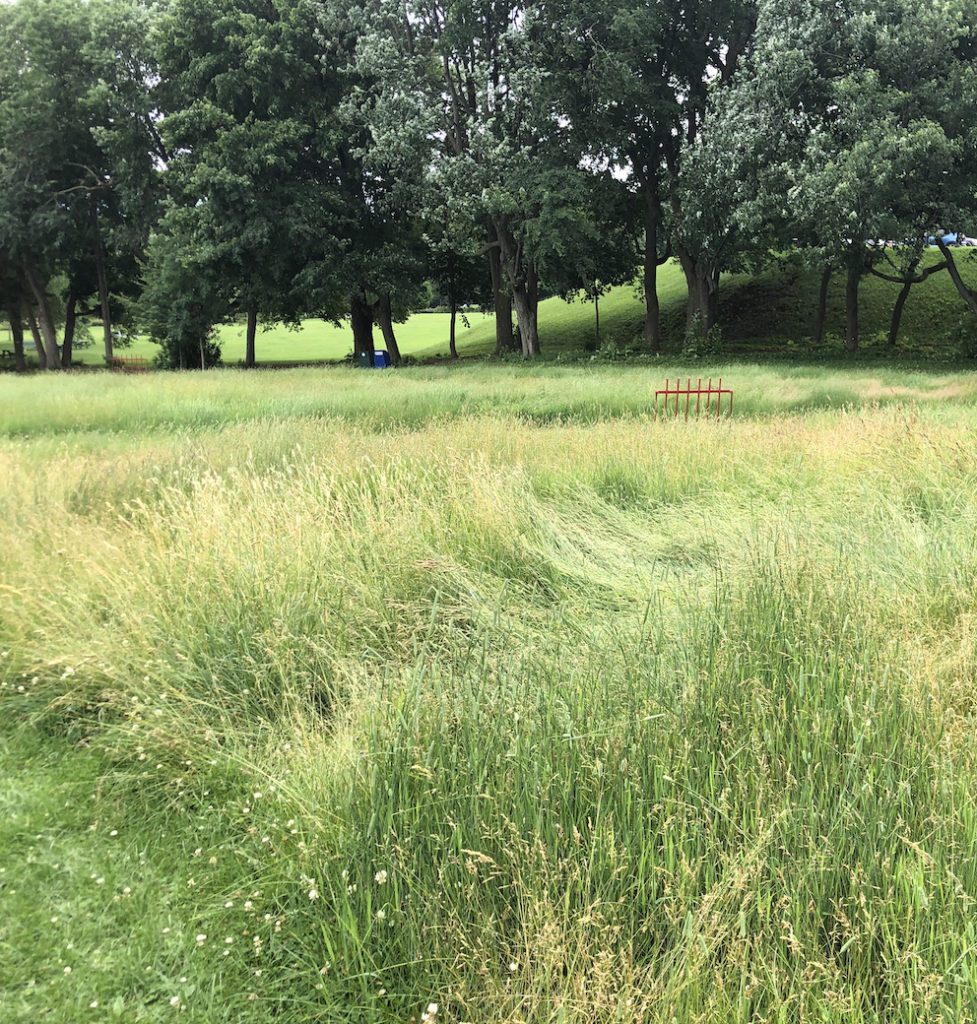
I installed six pieces of wrought iron barriers, painted bright red, sporadically positioned as benchmarks around the edges of the changing field. They functioned as a sort of fence more permeable than barriers, reminding us of the futility of our private properties and political borders which are freely and joyfully ignored by wild floral and faunal communities. But their presence also signaled a shift in the park’s occupation of the territory that is traditionally mowed to a perfect half-inch every week, quietly being transformed by the will of the variety of grasses and wild plants that were left alone to grow. Here and there the field was punctuated and annotated by the red structures, bearing witness, standing tall, and impeding a quick, thoughtless passage by the mowing machines. The entryway to the wild garden was indicated by an ornate iron gateway, also painted red, a sort of portal into another world, signaling a shift towards sharing space and being with our otherness. From the gateway, I manually mowed a spiral pathway, allowing the visitor to enter the re-wilding place, creating a path for humans to gently walk amongst the growing.

I invited the local poet Marilyne Busque-Dubois to engage in the place, in the same spirit of moving aside and listening. She visited the site several times, spending the afternoon sitting amongst the buzz and grow of the changing plants, birds and insects, her writing inspired by this process of continual, complex change to which we bore witness during the summer-time of the project. I stenciled the words that emerged from her visits onto up-cycled cement garden borders, the kitschy kind we (ironically) most often use to prevent weeds from encroaching into maintained and meticulous flower beds, as my grandfather had around his roses. Her words created an important bridge of receptivity and understanding between our human desire to control and conquer and the powerful action of letting go, moving aside, and letting the wild be wild.
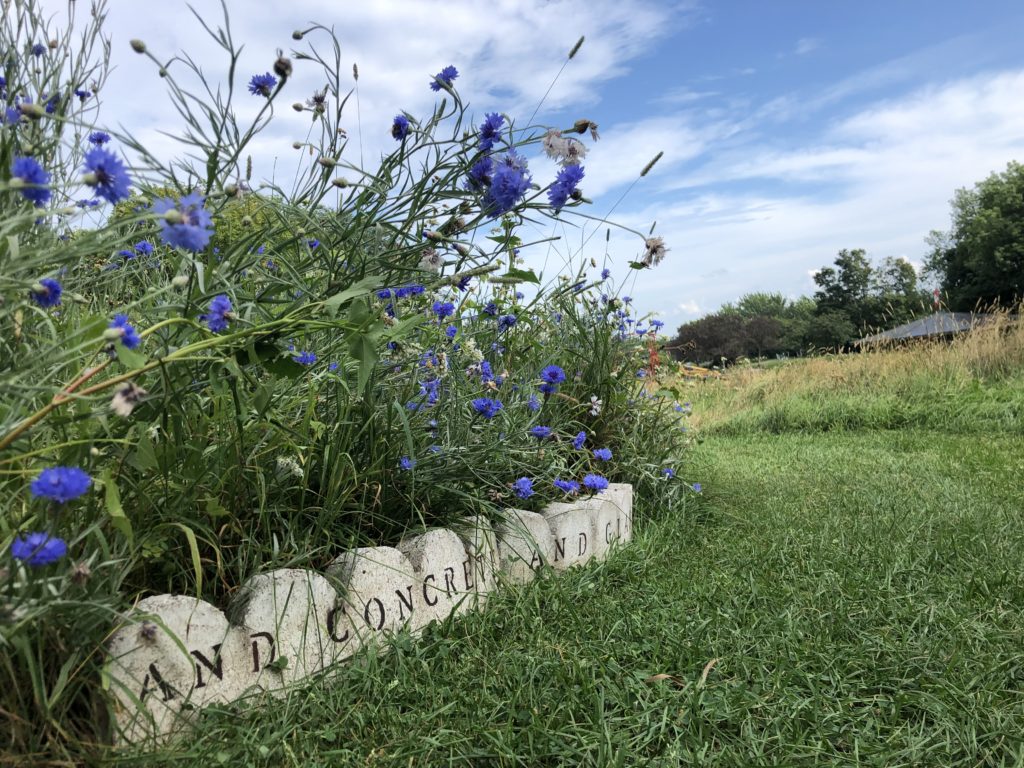
As the summer progressed and the plants were allowed to grow in the protected zone, my role as artist morphed from director of operations into steward of this wilding place. Each week I came to mow with a manual lawnmower the small pathways that allow passersby to enter the field. I also engaged in a weekly identification of the new plant species that arrived, researching their origins as well as their varied ecological and cultural functions. Once these tasks were done, I sat in the field, watching and listening, drawing the new plants in an evolutive drawing that followed the floral pace of change.
I was also present to receive the comments and questions of passersby. Adult visitors were interested in the biodiversity that such habitats harbor, observing the dragonflies, bees and songbirds that dashed through the tall grasses and flew overhead, wondering aloud why we don’t prioritize wildflower fields in our public parks. Several older visitors shared childhood memories of a beautiful, wild countryside where they spent their summers, recalling the smell and the soft textures of the grasses with intimacy and emotion. To my pleasant surprise, the children who visited the project took great pleasure in running through the field, with no hesitation, ignoring the carefully mowed path (which I then realized was more for the adult visitors), gleefully experiencing the freedom of the place through their bodies. Marilyne’s words on the garden stones guided them down one of the paths (which they referred to as labyrinths): ‘turn, turn again, slow down, lie down, listen to the sound of the monarch butterfly’s wings, the argument is over’ (translated from the original French version).
When I took a school group through the project, we followed all the poet’s directives (lying down in the tall grasses in the sun was particularly enjoyed). When we arrived at the last stones, I asked them what argument Marilyne was referring to. The children jumped up and down, excited to answer ‘I know, I know, it is our fight against nature, when we are always mowing the plants down!’ Through their corporal, sensory, artistic experiences of the place, the ecological message was also internalized and understood.
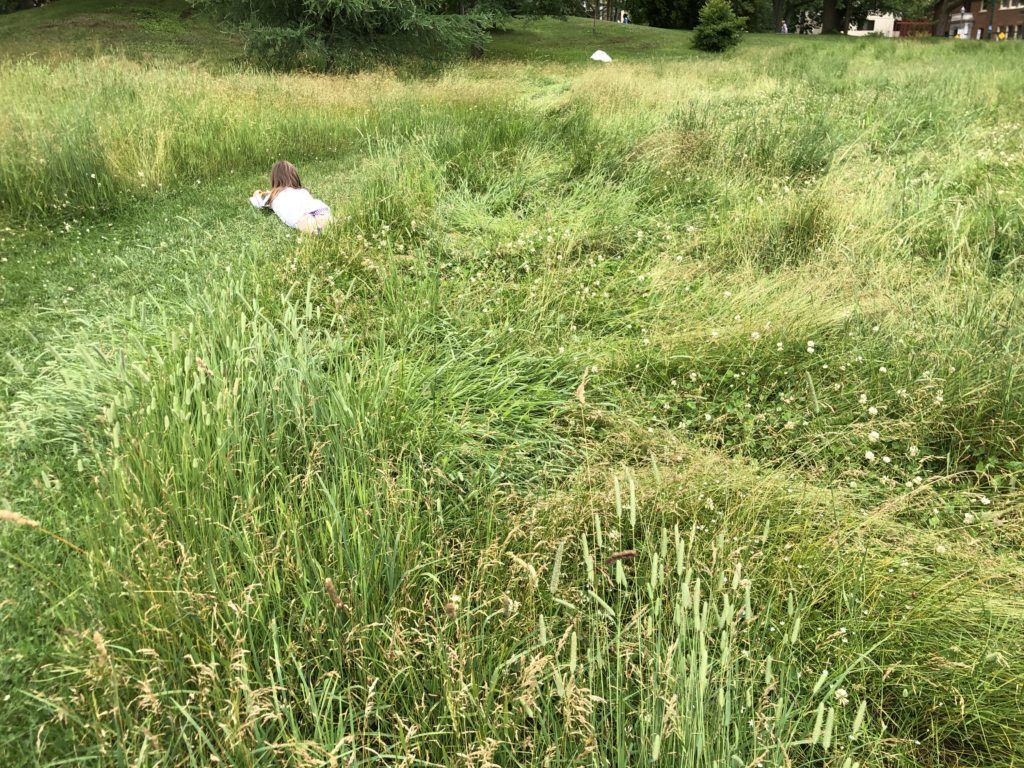
Each generation found a different anchorage place to the project, through memory, scientific reflection and interest, and sensory experience, often in a custom-made combination of the three. The artistic aspects of the project united the different modes of experience, entering another world through the red ornate gateway where poetic words and phrases lined the hand-mowed pathways, with the fragments of fences that reminded us that ultimately, nature has the power and the resilience to break down all our artificially-imposed barriers and borders, paradigms and norms.
II. WHAT THE WILD PLANTS TEACH US
THROUGH MY ART PRACTICE, I hope to address the urgent need for decolonized, eco-socio-artistic restoration actions. The restoration that needs to happen touches the ecological but also the human realms, addressing the problem: which is in more dire need of care, our natural environment, or our relationship to it? Potawatomi botanist Robin Wall Kimmerer wrote: ‘We need acts of restoration, not only for polluted waters and degraded lands, but also for our relationship with the world’ (Kimmerer, 2013, p. 195).
In auditing a restoration ecology course at Université Laval recently, I learned that there is great controversy over the idea put forth by restoration ecologists (Jones et al., 2018) that passive forms of restoration ecology (basically leaving nature alone to restore herself with minimal human interference) might be as effective as active ones (where humans, through great cost and effort, do concerted, sometimes invasive, rehabilitation and strategic plantings to speed along the restoration process). This finding provoked the question; what if the most powerful act we can currently do as a human in our present context is to step aside, to make room, to do less, to listen and observe more, and to slow down to plant-time? French biologist Francis Hallé said: ‘One must accept to have the wonder-infused experience of absolute otherness. If animals are the masters of space, plants are the masters of time’ (Veyrieras, 2018, p. 59). If plants are the masters of time, understanding the strength of the passive and slow, perhaps we can look to them as teachers, wisely showing us the way out of our frenzied pace.
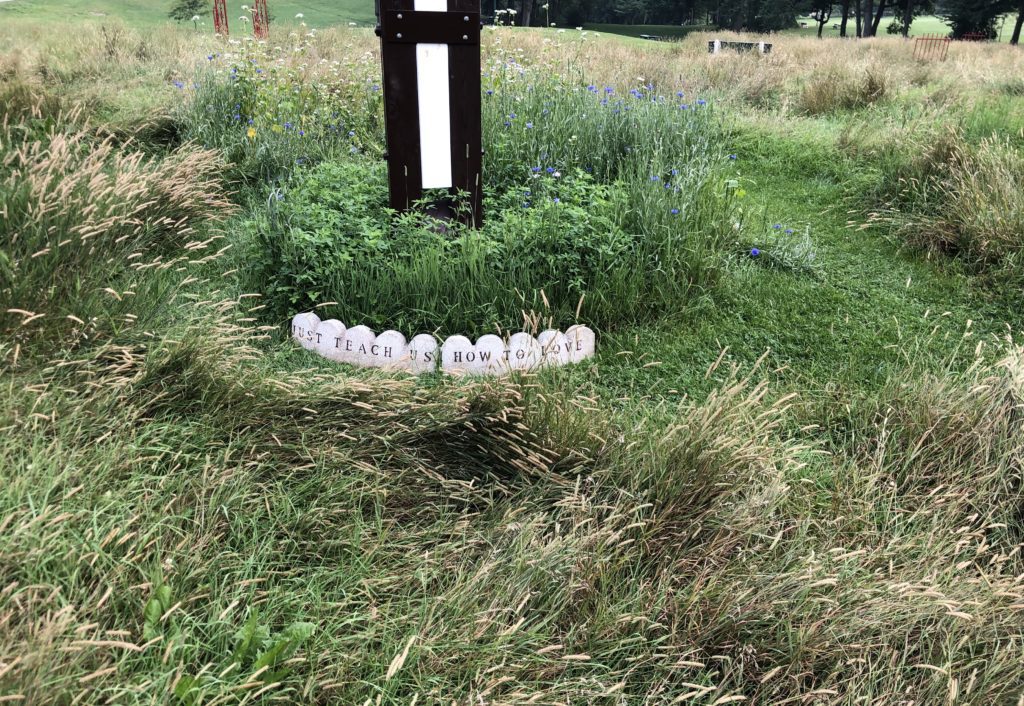
Charlene Spretnak explores the idea of radical non-duality in ecofeminist thought. Our glorification of the individual has perpetuated ‘the perception of an essential, protective separation between the self and the rest of the world—a radical discontinuity. . . hence the self is felt to be threatened with obliteration if unitive dimensions of being are recognized’ (Spretnak, 1997, p. 426). We feel insecure rather than reassured by the ecosystemic web that supports and sustains us, more comfortable with images of the autonomous individual, with the human at the apex of the pyramid. Kimmerer (2013) also refers to this socio-ecological strata in Western (colonial) tradition, where;
. . . there is a recognized hierarchy of beings, with, of course, the human being on top—the pinnacle of evolution, the darling of Creation—and the plants at the bot-tom. But in Native ways of knowing, human people are often referred to as the ‘younger brothers of Creation.’ We say that humans have the least experience with how to live and thus the most to learn—we must look to our teachers among the other species for guidance. (p. 9)
With humility we can choose to slow down, listen, and learn from our wild plant kin. They may have the answers to teach the way forward in these frightening times, with their highly attuned communal intelligence and networked sentience, proposing holistic solutions out of the mess we have made. Their ‘weediness’ is what helps them to survive in our post-industrial, contaminated landscapes. What perhaps we didn’t like about them (their unruly ways and behaviors) can also be seen as a beautiful resilience, thriving amongst our most traumatized lands, pulling out toxins, nourishing the soil with nitrogen, making compost and building biomass, attracting birds and pollinators. These weeds are the magic-makers of desolate places, putting the ‘Planthropocene’ (Myers, 2018) back into the Anthropocene. I find it interesting to see the parallels between what I validate in my art practice—the importance of the slowed down, manual, attentive—and what the wild plants teach us when we pause, look and listen.
III. NEW WILDERNESSES
I AM PROPOSING that we resist the apocalyptic fantasies that tempt apathy and tell us the earth will be much better without us. While the doomsday figures and realities cannot be denied (negative feedback loops triggered by the melting permafrost, the madly accelerating human population growth and GNP curve mirroring the rapidly accelerating biodiversity decline and migrant refugee populations), we need to reflect upon our place in the world, our ‘response-ability’ (Haraway, 2016).
In decolonializing our worldview, we consciously make way for the teachings of the indigenous peoples who know how to take care of and live harmoniously with nature’s systems, from pre- to post-colonial worlds. Tao Orion (2015) challenges the western conception of wilderness, which she says denies the work of indigenous Americans in stewarding the lands and taking care of the forests, biodiverse prairies, healthy rivers, and the structure of the plant and animal community assemblages that were carefully shaped by interactions with humans. She maintains that ‘wilderness’ as a pristine, untouched-by-humans realm simply didn’t exist, that the balance and beauty found in natural landscapes was created through a careful collaboration between (indigenous) humans and the other species. This rhymes with my conception of the ‘wild-garden’, which may appear as a contradiction or opposition of terms, but which signals new relationships that can emerge from this fraught time to include our care and relationship to and with our plant kin. Haraway’s alternative proposition to the Anthropocene rings true here, that of the ‘Chthulucene’, which requires ‘sym-poiesis (making with)’ rather than ‘auto-poiesis (self making)’, where we enter into relationship and collaboration with our other species-kin.
‘Maybe, but only maybe, and only with intense commitment and collaborative work and play with other terrans, flourishing for rich multispecies assemblages that include people will be possible’ (Haraway, 2015, p. 160).
This feels so different from a Cartesian separation of human and nature, or nature and culture, and relies on messy relationships between species and disciplines to find new ways of being, creating and caring in and for the world.
Through my work, I see eco-socio-artistic restoration projects as intentional acts of care, addressing the need to respond to a triad of healing: in the intimate, community, and environmental realms. Understanding how to live in our current anthropocentric era implicates a massive humbling of humanity and emphasizes the urgent need to re-insert ourselves within the systems of nature (rather than functioning as if we were separate from her). Kimmerer (2013) suggests the economy of the commons as a viable alternative, where the resources and land fundamental to life are held in common rather than commodified and privatized, echoing the Indigenous worldview in which the earth is taken care of ‘with respect and reciprocity for the benefit of all’ (p. 376).
Public art projects like It’s Really Just a Love Story can create context and opportunity for joint learning and sharing together around ideas of cohabitation and altruistic territories, enriched by our relationships with the wild plants who we begin to experience and understand as kin.
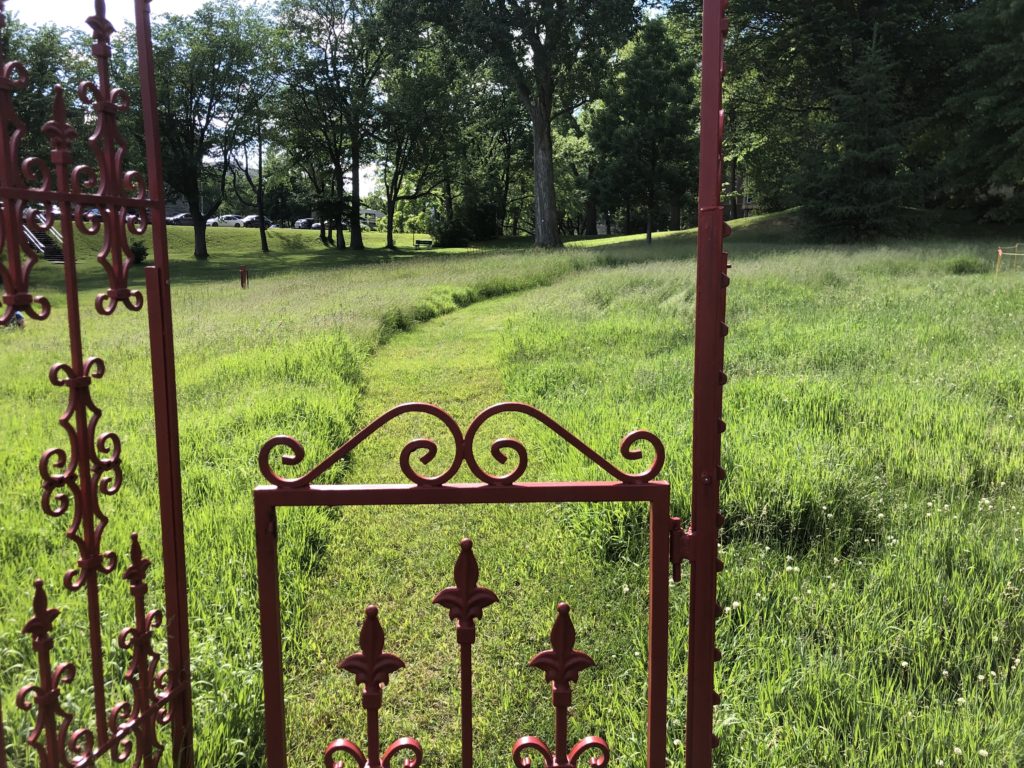
In a recent discussion I had with artist Jocelyn Robert on the site of It’s Really Just a Love Story, he saw the act of delineating a wild zone in the controlled milieu of the Plains of Abraham Park as a paradigm shift, reversing our current conceptions of sacred space. For centuries, sacred space has been defined as a protected area with clearly defined rules and social order, places in which liberty and wildness were excluded. In my project, to safeguard a territory from being continually mowed and controlled, I created a marked perimeter within which these social norms and habits (mowing, weeding, controlling the environment) were excluded. The rewilding space of floral liberty became a new sacred space, perhaps the sort of sacred space we most urgently need in the 21st century (referring to pre-Christian and indigenous worldviews of the sacredness of the wild). In our present context, it has become necessary for humans to safeguard the wild from the domination and control of the human presence (ironic but true).
Presented through the lens of an artistic project, with the aesthetic measures of poetic words, sculptural elements, and care-full drawings of the wild spontaneous plants, a bridge is created, a hand is extended from the statistics, and knowledge to our experiences of wonder, of discovery, of interspecies relationship, and hopefully healing.
REFERENCES
Haraway, D. (2015). Anthropocene, capitalocene, plantationocene, chthulucene: Making kin.
Environmental Humanities, 6(1), 159-165. doi: 10.1215/22011919-3615934
Haraway, D. (2016). Staying with the trouble: Making kin in the Chthulucene. Duke University Press.
Hobart, H. I. J. K., & Kneese, T. (2020). Radical care: Survival strategies for uncertain times.
Social Text, 38(1), 1-16. doi: 10.1215/01642472-7971067
Jones, H. P., Barbier, E. B., Blackburn, R. C., Rey Benayas, J. M., Holl, K. D., McCrackin, M., . . . Mateos, D. M. (2018). Restoration and repair of earth’s damaged ecosystems. Procceedings of the Royal Society B: Biological Sciences, 285(1873), 2017-2577. doi: 10.1098/rspb.2017.2577
Kimmerer, R. W. (2013). Braiding sweetgrass. Milkweed Editions.
Myers, N. (2018). How to grow liveable worlds: Ten (not-so-easy) steps for life in the plan-throposcene. In K. O. Smith (Ed.), The World to come, art in the age of the Anthropocene (pp. 53-63). Samuel P. Harn Museum of Art.
Orion, T. (2015). Beyond the war on invasive species, a permaculture approach to ecosystem restoration. Chelsea Green Publishing.
Spretnak, C. (1997). Radical nonduality in ecofeminist philosophy. In K. J. Warren (Ed.), Ecofeminism, Women, Culture, Nature. Indiana University Press.
Veyrieras, J.-B. (2018). Vers un nouveau lien avec le monde végétal? Science et vie, 1203, 26-60.
Young, I. (2018, March 15). Nature as the great equalizer. https://forthewild.world/listen/ rue-mapp-on-nature-as-the-great-equalizer
Notes
1The biologist Edward O. Wilson defined biophilia as “the urge to affiliate with other forms of life”. Edward O. Wilson, Biophilia (Cambridge, Massachusetts and London, England: Harvard University Press, 1984), 85.
WEAD MAGAZINE ISSUE No. 13, THE ART OF EMPATHY
Published November 2022
